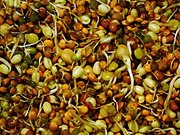Sprouting
Sprouting is the practice of soaking, draining, then rinsing at regular intervals seeds until they germinate and begin to sprout.
Contents |
Seeds that can be sprouted
One of the most common sprouts is that of the mung bean (Vigna radiata), often sold as ‘Chinese Bean Sprouts’; another common sprout is the alfalfa sprout.
Other seeds that can be sprouted include adzuki bean, almond, amaranth, annatto seed, anise seed, arugula, barley, basil, kidney bean, navy bean, pinto bean, lima bean, broccoli, buckwheat, cabbage, canola seed, caragana, cauliflower, celery, chia seed, chickpeas, chives, cilantro (coriander), clover, cress, dill, fennel, fenugreek, flax seed, garlic, hemp seed, kale, kamut, kat, leek, green lentils, millet, mizuna, mustard, oats, onion, black-eyed peas, green peas, snow peas, peanut, psyllium, pepita (pumpkin seeds), quinoa, radish, rye, sesame, soybean, spelt, sunflower, tatsoi, triticale, watercress, and wheat berries.
With all seeds, care should be taken that they are intended for sprouting or human consumption rather than sowing. Seeds intended for sowing may be treated with chemical dressings. Several countries, such as New Zealand, also require that some varieties of edible seed be heat-treated, thus making them impossible to sprout.
Sprouting
Moisture, warmth, and in most cases, indirect sunlight are necessary for sprouting. Some sprouts, such as mung beans, can be grown in the dark. Little time, effort or space is needed to make sprouts.
To sprout seeds, the seeds are moistened, then left at room temperature (between 13 and 21 degrees Celsius) in a sprouting vessel. Many different types of vessels can be used. One type is a simple glass jar with a piece of cloth secured over its rim. ‘Tiered’ clear plastic sprouters are commercially available, allowing a number of "crops" to be grown simultaneously. By staggering sowings, a constant supply of young sprouts can be ensured. Any vessel used for sprouting must allow water to drain from it, because sprouts which sit in water will rot quickly. The seeds will swell and begin germinating within a day or two.
Sprouts are rinsed as little as twice a day, but possibly three or four times a day in hotter climates, to prevent them from souring. Each seed has its own ideal sprouting time. Depending on which seed is used, after three to five days they will have grown to two or three inches in length and will be suitable for consumption. If left longer they will begin to develop leaves, and are then known as baby greens. A popular baby green is sunflower after 7-10 days. The growth process of any sprout can be slowed or halted by refrigerating until needed.
Common causes for sprouts to turn out inedible:
- Seeds are allowed to dry out
- Seeds are left in standing water
- Temperature is high or too low
- Insufficient rinsing
- Dirty equipment
- Insufficient air flow
These problems are easily solved by an automatic sprouter that mists and drains the sprouts at regular intervals. To control temperature, in the winter a warming blanket can be placed under the sprouter, and in the summer small fans in the lid if it's very hot and humid.
Mung beans can be sprouted either in light or dark conditions. Those sprouted in the dark will be crisper in texture and whiter, as in the case of commercially available Chinese Bean Sprouts, but these have less nutritional content than those grown in partial sunlight. Growing in full sunlight is not recommended, because it can cause the beans to overheat or dry out. Subjecting the sprouts to pressure, for example, by placing a weight on top of them in their sprouting container, will result in larger, crunchier sprouts similar to those sold in Polish grocery stores.
Nutritional information and precautions
Sprouts are rich in vitamins, minerals, Amino Acids, proteins and phytochemicals, as these are necessary for a germinating plant to grow[citation needed]. They are also rich in nutrients essential for human health[citation needed].
Some legumes can contain toxins, which can be reduced by soaking, sprouting and cooking (eg, stir frying). Joy Larkcom, advises that to be on the safe side “one shouldn’t eat large quantities of raw legume sprouts on a regular basis, no more than about 550g (20oz) daily”.[1]
Sprouting and the Living foods diet
Advocates of a raw food diet promote the use of sprouting as an effective way to increase the nutrient value, and digestibility, of beans, seeds and nuts. Sprouts are in fact the most nutrient dense food on earth[citation needed] – nutrient density refers to the amount of nutrients per calorie. This is why many people on a low-calorie diet make sprouts and baby greens the mainstay of their diet, especially blended for easier digestion.
References
- ↑ Larkcom, Joy ‘Salads For Small Gardens’, p.98 Hamlyn 1995 ISBN 0-600-58509-3
- The Raw Truth by Jeremy A Safron, (Celestial Arts, Toronto, 2003) ISBN 1-58761-172-4 (pbk.)

